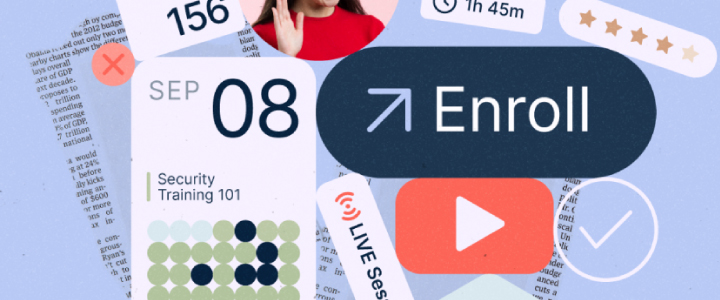
5 min reading time
What is Adult Learning Theory?
Every trainer’s ambition is to make corporate learning as impactful and engaging as possible. But how? One method to master great training and course creation is by understanding how your learners’ learn.
Adult Learning Theory, also known as andragogy, is a concept that has been around for years. It highlights the distinct ways adults best respond to learning and it’s a must-know for any training provider. Adult learning is a relatively simple theory to grasp, so let’s explain what it is and how its principles can be applied to your corporate learning strategy.
If you’re interested in hearing from an expert about brain-based tactics that leverage how adults learn, check out our upcoming Learning Impact session with Dr. Allison Friederichs!
What is Adult Learning Theory?
Developed by Malcolm Knowles in 1968, Adult Learning Theory or andragogy is the concept or study of how adults learn and how it differs from children. It aims to show how adult learning is distinct and identify the learning styles which suit them best.
Over the years, the theory has been added to and adapted. At its core, it contains five key assumptions about adult learners and four principles of andragogy. It’s a theory that is applicable for businesses in particular as it works well for common training courses, like soft-skills.
5 Key Assumptions of Knowles’ Adult Learning Theory
A central part of Knowles’ Adult Learning Theory refers to five (sometimes six) assumptions. Each one outlines the general ways in which adults perceive learning and how they prefer to train.
1. Self-Concept
As we grow older, we shift from being dependent to being more independent. Therefore, how we prefer to learn changes from being instructor-led to a more self-directed approach.
2. Adult Learner Experience
Adults have lots of experience from which they draw knowledge and references. We can take from these experiences and learn from them.
3. Readiness to Learn
Adults want or are ready to learn when there is a reason, such as when it’s directed towards growth and development related to their work.
4. Orientation of Learning
As adults, we want what we are learning to be actually applicable to our everyday lives, instead of being general learning about a subject. We want to learn practical skills that help us solve problems and work better.
5. Motivation to Learn
As children, we learn because of external factors, like parents and teachers. However, as adults we want to learn for our own reasons, for example, to progress in work or to boost self-esteem.
4 Principles Of Andragogy
Considering that adults have their own, unique way of learning, there are 4 central principles that explain how to best develop training for them.
- When it comes to learning, adults want or need to be involved in how their training is planned, delivered, and executed. They want to control what, when, and how they learn.
- Adults gain more when they can pull past experiences into the learning process. They can draw on what they previously know to add greater context to their learning.
- Memorizing facts and information isn’t the right way for adults to learn. They need to solve problems and use reasoning to best take in the information they are being presented with.
- Adults want to know “How can I use this information now?”. What they are learning needs to be applicable to their lives and be implemented immediately.
Apply Adult Learning Theory to Your Corporate Learning
So, with Adult Learning Theory explained, how do you as a training provider use it practically for your corporate learning? Here are a few tips toward using this theory in your eLearning:
1. Analyze your learning with the theory in mind
Many instructional design methodologies, like ADDIE, have an analysis phase. Within this, you analyze everything from who, what, when, and where to how. This is also a perfect time to consider how andragogy applies.
At this stage, you should assess how previous training performed and whether it may or may not have fitted into the framework. Also ask how you can plan out the practical applications of training so your employees, customers, etc. see the real value of training for them.
2. Collaborate on the learning you’re providing
As mentioned above, adults like to be involved in every stage of their learning, so involve them as much as possible. For example, with employee training, before you develop courses ask what they actually want to learn and how they would like to learn.
During learning, encourage collaboration, opinions, and discussions with other learners and instructors. Then, once training is completed, ask for feedback on everything from exams to content to software used to train. It will give the learners a sense of participation throughout the process.
3. Enable self-directed learning
In the past, corporate learning has often been a mandatory activity done at a certain time. Now with technologies like an LMS, you can create a much more self-directed, independent learning environment for your adult learners.
You can allow them to train when and where they want, offer them a selection of courses that they can choose to enroll in and enable them to have their own distinct learning goals.
4. Use real-world learning examples
As the theory states, adults like to know how the training will have an immediate application and benefit for them. So, when creating your course content, inject it with as many real-world examples as possible.
If you’re training your customer on how to use your product, walk them step-by-step through a workflow they will actually be using and explicitly state how and why they would use it. For employee training, the same applies: state how the training will help, and then use genuine examples to train.
5. Let your learners figure it out themselves
Since adults prefer problem-solving over just the facts, when creating content it’s a good idea to not just lay out all the answers straight away. Why not get creative instead and build courses that get your learners’ brains going?
You can do this in a few simple ways, including adding assessments and simulations that outline specific problems a learner might actually encounter, and then getting your learners to use their skills to overcome it.
6. Experimentation is key
Adult Learning Theory has so many practical uses for your corporate learning. But, as always, the key to great learning is to experiment and test. Take pieces of the theory and apply it to your employee or customer training and see how it improves your learners’ experience.
Want to learn more about adult learning theory?
We’re delighted to welcome Dr. Allison Friederichs as guest speaker for our upcoming Learning Impact session, “Brain-based Tactics for Leveraging How Adults Learn”. Dr. Friederichs will share her science-backed techniques so you can leverage knowledge about how the adult brain learns to ensure that learning is actually taking place – regardless of the learner or context. You can find more information and register for this webinar here.




